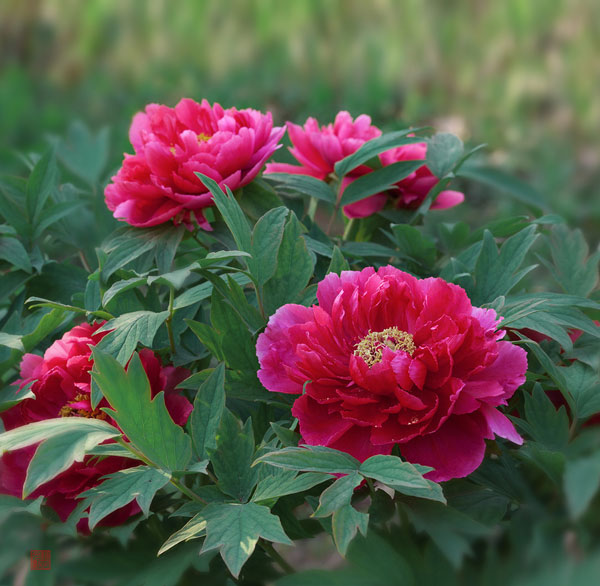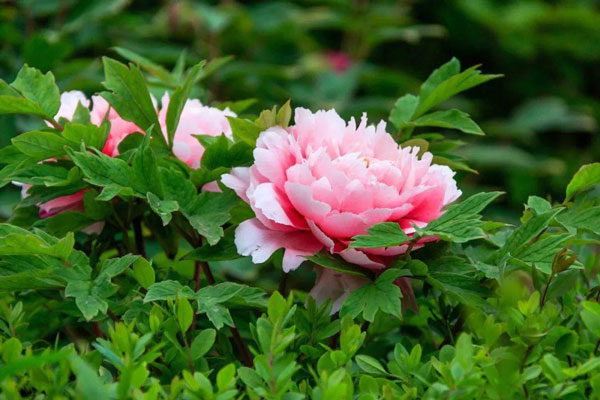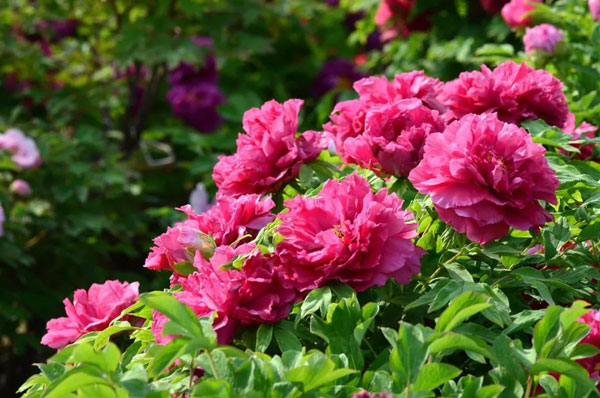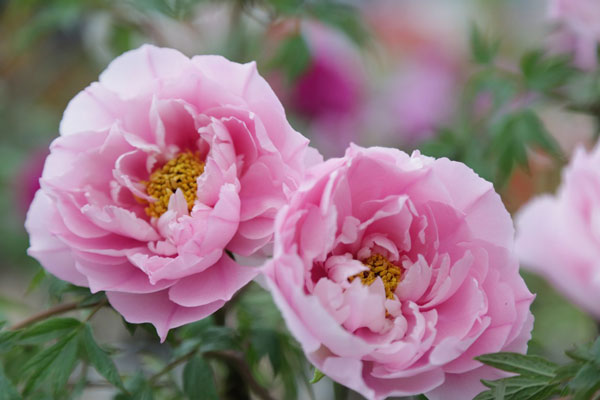Grow & Care for Tree Peony (Paeonia suffruticosa)
Written by Iris
Oct 22 2021

Tree Peony (Paeonia suffruticosa), a long-lived deciduous woody shrub. Although the growth rate is somewhat slow, a mature peony can have more than 50 flowers of 8-10 inches and will bloom for about two weeks. Once established, peonies are deer-resistant and fairly drought-tolerant. The Tree Peony is very suitable to grow in home garden. Here is the guide for how to grow and care for Tree Peony.


Collect the ripe seed once the seed pods begin to split in late summer and autumn. The viable seed is black. The red seed will not have been fertilized and will not germinate so can be discarded
Soon after collecting the seed, sow the seed 2.5cm (1in) deep in containers filled with John Innes
Seed compost is a free draining compost formulated for germinating seeds. It often contains a mix of fine materials including sterilized loam, coir, coarse sand, grit or perlite. It contains a low level of nutrients (High levels
could damage seedlings).
Make sure that the compost does not dry out in summer and protect from rodents
Peony seeds need to be exposed to two chilling periods with a warm spell between them. The seeds are doubly dormant; this means the root emerges the next spring after the first chilling period (winter), but the stem and leaves only appear after the second winter
The
Most tree peonies are commercially propagated by grafting, but this is not a technique commonly used by home gardeners as it takes quite a bit of practice to get good success rates.
Cuttings generally root poorly so are not a great option.

Paeonia suffruticosa 'Kinkaku': Bicolored flowers of pale yellow with pink edges; blooms a few weeks later than Paeonia suffruticosa 'Red'
Paeonia suffruticosa 'Kinshi': Also called the "Golden Bird," because it bears huge flowers in a golden-yellow color
P. suffruticosa 'Qing Xiang Bai': Produces single blooms (most tree peonies have double blooms)
Also note that newly planted peonies usually don't flower the first year, which is spent developing a good root system and foliage. By the second spring after planting, you should see your first blooms.
Read More: Tree Peony (Paeonia suffruticosa) profile
Tree Peony Quick InfoWhere to Grow Tree PenoyWhen to Grow Tree Peony (Paeonia suffruticosa)How to Propagate Tree Peony (Paeonia suffruticosa)Grow Tree Peony from SeedsTree Peony Propagation with Stem CuttingsHow to Care for Tree Peony (Paeonia suffruticosa)Tree Peony Light RequirementsTree Peony Soil CareTree Peony WateringTree Peony Temperature & Humidity CareTree Peony Fertilizer CareTree Peony PruningTree Peony Care - Pests & DiseasesTree Peony Varieties (Paeonia suffruticosa)Tree Peony (Paeonia suffruticosa) FAQHow come my Tree peonies don't bloom?
Tree Peony Quick Info
| Botanical/Scientific Name | Paeonia suffruticosa |
| Common Name | Tree peony |
| Varieties | P. suffruticosa 'Red' P. suffruticosa 'Kinkaku' P. suffruticosa 'Kinshi' P. suffruticosa 'Qing Xiang Bai' |
| Plant Height | 3 to 5 feet tall |
| Plant Width | 3 to 4 feet wide |
| Flower | White, red, pink, purple, yellow |
| Bloom Time | Spring |
| Uses | Indoor plant, potted plant with high ornamental value |
| Toxic | safe to cats and dogs |
Where to Grow Tree Penoy
Grow Tree Peonies in a sunny or lightly-shaded position. Tree peonies (Paeonia suffruticosa) are very hardy, but the foliage and flower buds can be damaged by late frosts so avoid frost pockets. Choose a sheltered position to prevent damage to flowers and foliage by strong winds. Tree peonies prefer neutral, humus–rich, well-drained soils, but they will tolerate slightly acid or slightly alkaline soils. It's possible to improve most soils enough by digging in organic matter, such as garden compost or well-rotted manure, but those which are very acidic or alkaline can remain unsuitable.
When to Grow Tree Peony (Paeonia suffruticosa)
Tree peonies (Paeonia suffruticosa) are best planted in autumn, but winter or early spring planting is also suitable. Avoid growing in late spring and in summer as Tree Peony plants will not grow well in hot, dry conditions.
How to Propagate Tree Peony (Paeonia suffruticosa)
Grow Tree Peony from Seeds
Species such as Paeonia delavayi can be grown from seed as can hybrids, but the latter will not breed true. You might get some interesting new hybrids but, in truth, they are often not as good as their named variety (cultivar) parent. It can still be interesting to try growing Tree Peony from seed, however, and occasionally you will see a self-sown seedling that you might like to grow on.Collect the ripe seed once the seed pods begin to split in late summer and autumn. The viable seed is black. The red seed will not have been fertilized and will not germinate so can be discarded
Soon after collecting the seed, sow the seed 2.5cm (1in) deep in containers filled with John Innes
Seed compost is a free draining compost formulated for germinating seeds. It often contains a mix of fine materials including sterilized loam, coir, coarse sand, grit or perlite. It contains a low level of nutrients (High levels
could damage seedlings).
- seed compost
- Mulch news
Make sure that the compost does not dry out in summer and protect from rodents
Peony seeds need to be exposed to two chilling periods with a warm spell between them. The seeds are doubly dormant; this means the root emerges the next spring after the first chilling period (winter), but the stem and leaves only appear after the second winter
The
- A seedling is a young Tree Peony grown from seed.
Tree Peony Propagation with Stem Cuttings
Layering is relatively straightforward if a flexible stem can be bent over. It usually takes two to three years before the stem will produce a sufficient independent root system to be separated from the parent Tree Peony (Paeonia suffruticosa).Most tree peonies are commercially propagated by grafting, but this is not a technique commonly used by home gardeners as it takes quite a bit of practice to get good success rates.
Cuttings generally root poorly so are not a great option.

How to Care for Tree Peony (Paeonia suffruticosa)
Tree Peony Light Requirements
Grow tree peonies (Paeonia suffruticosa) in full sun to dappled shade. The flowers may suffer in the hot summer sun; providing some shade helps.Tree Peony Soil Care
These Tree Peony (Paeonia suffruticosa) like to grow in a ground that is well-drained, with a soil pH that is neutral or slightly alkaline. They will thrive in loamy soil fortified with compost.Tree Peony Watering
Water Tree Peony regularly in dry spells during the first year to aid establishment, especially if planted in spring or later in the season. Established tree peonies are deep-rooted and after the first year should not need routine watering.Tree Peony Temperature & Humidity Care
Tree peonies (Paeonia suffruticosa) have chilling requirements, so they grow best in regions that experience cold temperatures during the winter. The further south you go in their range, the more sense it may make to grow them in dappled shade. For fall care, mulch to provide additional winter protection if you live in an area where the Tree Peony (Paeonia suffruticosa) plants are only borderline-hardy.Tree Peony Fertilizer Care
Adding a layer of compost or manure to the soil in spring will give the shrub a boost of nutrition when growing Tree Peonies. Many gardeners also like to feed their tree peonies with a foliar spray of fish emulsion later in the season.Tree Peony Pruning
Tree peonies (Paeonia suffruticosa) require minimal pruning. Just remove flowered shoots, cutting them off just above the new growth on the stem in summer; or in the autumn after the seeds are collected if this is desired. Remove any dead shoots in late winter, cutting back to a healthy bud. Stems may become leggy over many years. Cut them back by a third in the autumn after leaf-fall to encourage bushier growth. Tree peonies such as Paeonia delavayi f. lutea and Paeonia delavayi tend to produce more. Vigorous is healthy, fast-growing plant stems, especially when young growth is produced. Vigorous, upright stems. Removal of a proportion of the oldest stems at ground level in autumn helps to control the size once the Tree Peony (Paeonia suffruticosa) plants become established.Tree Peony Care - Pests & Diseases
On rare occasions, you may notice a hole in the woody stem, caused by a boring insect. You may be able to kill the larva in the tunnel using a thin wire, or simply cut out the affected area. Like Herbaceous Peonies, Tree Peonies are occasionally afflicted with fungal diseases that cause black spots on leaves and wilting of shoots. Remove any diseased foliage as soon as noticed and be sure to clean up all fallen Tree Peony parts in the autumn. If fungal diseases become a problem, spray with a fungicide early in spring, repeating the treatments for several weeks. Be diligent with deadheading and do not allow fallen petals to remain caught in the Tree Peony (Paeonia suffruticosa) or on the ground.
Tree Peony Varieties (Paeonia suffruticosa)
Paeonia suffruticosa 'Red': Bears a gorgeous pink flower (not red); blooms relatively early in springPaeonia suffruticosa 'Kinkaku': Bicolored flowers of pale yellow with pink edges; blooms a few weeks later than Paeonia suffruticosa 'Red'
Paeonia suffruticosa 'Kinshi': Also called the "Golden Bird," because it bears huge flowers in a golden-yellow color
P. suffruticosa 'Qing Xiang Bai': Produces single blooms (most tree peonies have double blooms)

Tree Peony (Paeonia suffruticosa) FAQ
How come my Tree peonies don't bloom?
Failure to bloom is usually caused by two things: improper planting and/or insufficient light. When growing Tree Peonies, make sure to plant the eyes (the point at which new growth emerges) no more than two inches deep. Also make sure your Tree Peony (Paeonia suffruticosa) plants get plenty of sun — 6 or more hours a day. If they're planted in a shady site, they will not flower well — if at all.Also note that newly planted peonies usually don't flower the first year, which is spent developing a good root system and foliage. By the second spring after planting, you should see your first blooms.
Read More: Tree Peony (Paeonia suffruticosa) profile
Latest Updated
- Benefits of Bugleweed - 7 Science-backed Health Benefits
- Bugleweed Dangers & Side Effects - Is It Poisonous?
- How to Plant Evergreen Trees - What You Should Know
- When to Plant Evergreens - Grow Guide for Evergreen Trees
- 12 Wonderful Evergreen Shrubs for Your Garden
- 12 Popular Evergreen Plants with Pictures for Beginners
- When And How To Prune A Lilac Bush Like a Pro
- How to Grow & Care for Lilac Vine (Hardenbergia Violacea)
- Japanese Lilac Tree (Syringa Reticulata) Care & Propagation Guide
- Shumard Oak Pros and Cons - What to Know
Popular Articles
- Winter maintenance of Antirrhinum Majus
- How to Grow Terminalia Mantaly Tree
- How to Grow and Care for Crossostephium Chinense
- How to grow Antirrhinum Majus in spring
- Peristeria Elata (Dove Orchid) Profile: Info & Care Guide
- Underwatered Snake Plant (Sansevieria Trifasciata) - Signs And How To Fix
- How to Care for Brazilian Jasmine Plant (Mandevilla Sanderi)
- How to Grow & Care for Graptopetalum Purple Delight in Summer
- Rosa Chinensis (China Rose): Plant Growing & Care Tips
- How to Care for Baby Sun Rose (Aptenia Cordifolia)